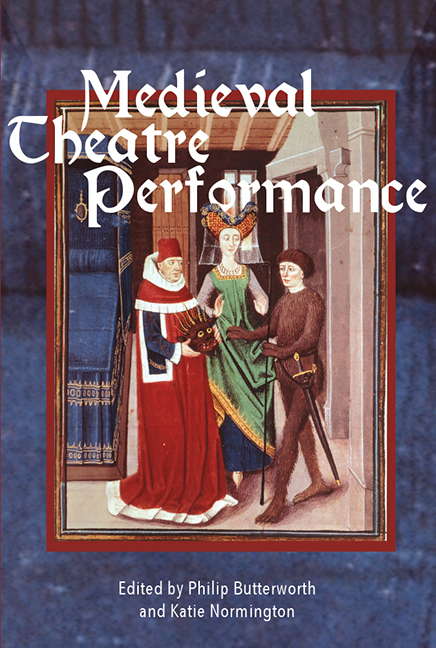Book contents
- Frontmatter
- Dedication
- Contents
- List of Illustrations
- Contributors
- Abbreviations of Principal Sources Cited
- Introduction
- Synopses
- 1 From Archive to Repertoire: The Disguising at Hertford and Performing Practices
- 2 Walk, Talk, Sit, Quit? On What Happens in Netherlandish Rhetoricians’ Plays
- 3 Performing Intrusions: Interaction and Interaxionality in Medieval English Theatre
- 4 Player Transformation: The Role of Clothing and Disguise
- 5 Pavilioned in Splendour: Performing Heaven in Fifteenth-Century Florence
- 6 Living Pictures: Drama without Text, Drama without Action
- 7 Performer-Audience Relationships in Fifteenth- and Sixteenth-century Danced Spectacles
- 8 Decadance in the Late Middle Ages: The Case of Choreomania
- 9 Writing, Telling and Showing Horsemanship in Rhetoricians’ Farce
- 10 Inanimate Performers: The Animation and Interpretive Versatility of the Palmesel
- 11 ‘lyke unto a lyvelye thyng’: The Boxley Rood of Grace and Medieval Performance
- 12 The Mechanycalle ‘Ymage off Seynt Iorge’ at St Botolph's, Billingsgate, 1474
- Bibliography
- Index
1 - From Archive to Repertoire: The Disguising at Hertford and Performing Practices
Published online by Cambridge University Press: 21 August 2018
- Frontmatter
- Dedication
- Contents
- List of Illustrations
- Contributors
- Abbreviations of Principal Sources Cited
- Introduction
- Synopses
- 1 From Archive to Repertoire: The Disguising at Hertford and Performing Practices
- 2 Walk, Talk, Sit, Quit? On What Happens in Netherlandish Rhetoricians’ Plays
- 3 Performing Intrusions: Interaction and Interaxionality in Medieval English Theatre
- 4 Player Transformation: The Role of Clothing and Disguise
- 5 Pavilioned in Splendour: Performing Heaven in Fifteenth-Century Florence
- 6 Living Pictures: Drama without Text, Drama without Action
- 7 Performer-Audience Relationships in Fifteenth- and Sixteenth-century Danced Spectacles
- 8 Decadance in the Late Middle Ages: The Case of Choreomania
- 9 Writing, Telling and Showing Horsemanship in Rhetoricians’ Farce
- 10 Inanimate Performers: The Animation and Interpretive Versatility of the Palmesel
- 11 ‘lyke unto a lyvelye thyng’: The Boxley Rood of Grace and Medieval Performance
- 12 The Mechanycalle ‘Ymage off Seynt Iorge’ at St Botolph's, Billingsgate, 1474
- Bibliography
- Index
Summary
Here is what we know.
It happened during the long holiday season that stretched from late November through to January. It took place in Hertford Castle, some twenty miles north of London. It featured a performance before an unnamed king, whom we can deduce was the young heir to the English throne, Henry VI. It took the form of a disguising of countrymen complaining about their wives and the wives’ response, followed by the king's decision. It was staged at the request of John Brice, the royal household's deputy controller, who would die in battle a few years later in France. It was devised by John Lydgate, monk of the great Benedictine monastery of Bury St Edmunds and England's most famous living poet.
So we know who was (partially) involved in it, what it was (sort of), when it occurred (more or less), where it took place, and why (as part of the tradition of holiday entertainments in the royal household) it took place.
But consider what we do not know. We do not know who else helped plan the disguising beyond Brice and Lydgate, who else in addition to the king was in the audience, or who played the roles of the countryfolk husbands and wives. We do not know what this disguising (if that is what it was) looked or sounded like, what costumes were used or what actions performed. We also do not know exactly when it took place, although 1427 seems the best guess. And we do not know why a performance on this specific subject matter was chosen for the amusement of the king, who, after all, was only six years old.
That is quite a lot that we do not know, and many of those unknowns fall under a category that I left out of my list of who, what, when, where, and why. The missing category is of course how the performance watched by the king was put on—how lines were spoken; how parts were assigned to actors; how those actors moved, spoke and gestured; how stage properties and costumes were designed; how sound and other effects were deployed; how music and dance were used; and how the audience reacted.
- Type
- Chapter
- Information
- Medieval Theatre PerformanceActors, Dancers, Automata and their Audiences, pp. 15 - 34Publisher: Boydell & BrewerPrint publication year: 2017

